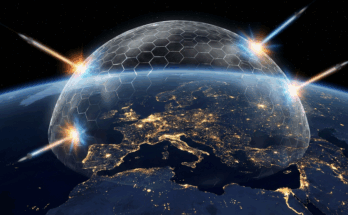By Bill Ostrove, Space Systems Analyst, Forecast International.

For the first time, scientists have observed ripples in the fabric of space-time called gravitational waves. The detection was made on September 14, 2015, by the Laser Interferometer Gravitational-Wave Observatory (LIGO). LIGO encompasses a pair of ground-based observatories in Hanford, Washington, and Livingston, Louisiana – both of which are funded by the National Science Foundation (NSF). The discovery was confirmed on February 11, 2016.
The new LIGO discovery – the first observation of gravitational waves themselves – was made by measuring the tiny disturbances the waves make to space and time as they pass through the Earth.[i]
Albert Einstein predicted the existence of gravitational waves in his general theory of relativity a century ago, and scientists have been attempting to detect them for 50 years. Einstein pictured these waves as ripples in the fabric of space-time produced by massive, accelerating bodies, such as black holes orbiting each other. Scientists are interested in observing and characterizing these waves to learn more about the sources producing them and about gravity itself.
Scientists foresee the discovery as a first step toward opening a whole new branch of astrophysics. Nearly everything known about the universe comes from detecting and analyzing light in all its forms across the electromagnetic spectrum – radio, infrared, visible, ultraviolet, X-rays and gamma rays. The study of gravitational waves opens a new window on the universe, one that scientists expect will provide key information that will complement what can be learned through electromagnetic radiation.
While the discovery is a major scientific achievement, it could have spending implications as well. According to NASA, the ground-based LIGO is sensitive to gravitational waves within the range of 10 to 1,000 cycles per second (10 to 1,000 Hz). A space-based system would be able to detect waves at much lower frequencies, from 0.0001 to 0.1 Hz, and detect different types of sources.[ii]

The European Space Agency (ESA) is currently leading the LISA Pathfinder mission to demonstrate technologies that could be used for a future space-based gravitational wave observatory. The mission was launched last December and is now in its commissioning phase. Notably, the LISA Pathfinder mission was once seen as a precursor to a much more ambitious mission called the New Gravitational Wave Observer. However, that mission was not selected for an L-class launch slot because it was considered too costly.
With the announcement of the discovery of gravitational waves, space agencies will likely take another look at a space-based gravitational waves detector. ESA L-class missions are currently capped at just over $1 billion each. The most recent estimate for the NGO mission put the cost at $1.4 billion. ESA could work with foreign space agencies to spread the cost around. NASA and JAXA are likely partners.
[i] http://www.nsf.gov/news/news_summ.jsp?cntn_id=137628&org=NSF&from=news
ii http://www.nasa.gov/feature/goddard/2016/nsf-s-ligo-has-detected-gravitational-waves
A military history enthusiast, Richard began at Forecast International as editor of the World Weapons Weekly newsletter. As the Internet grew in importance as a research tool, he helped design the company's Forecast Intelligence Center and currently coordinates the EMarket Alert newsletters for clients. Richard also manages social media efforts, including two new blogs: Defense & Security Monitor, covering defense systems and international issues, and Flight Plan, which focuses on commercial aviation and space systems. For over 30 years, Richard has authored the Defense & Aerospace Companies, Volume I (North America) and Volume II (International) services. The two books provide detailed data on major aerospace and defense contractors. He also edits the International Contractors service, a database that tracks all the contractors involved in the programs covered in the FI library. More recently he was appointed Manager, Information Services Group (ISG), a new unit that encompasses developing outbound content for both Forecast International and Military Periscope.




